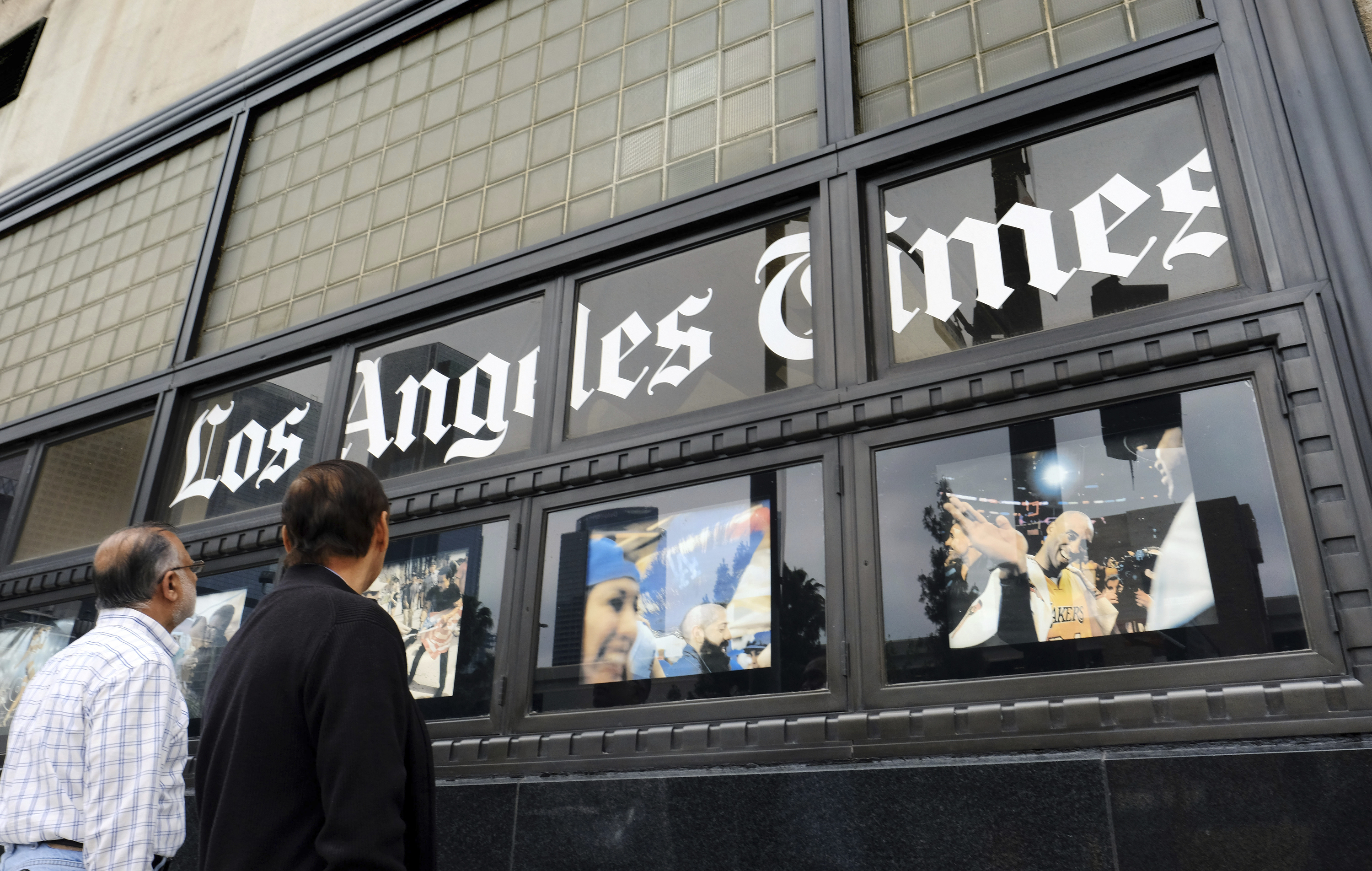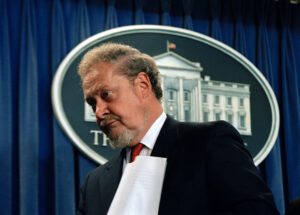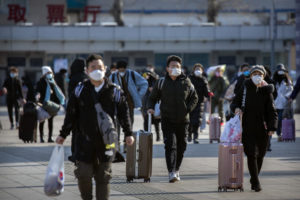Can the Los Angeles Times’ Revival Endure?
Dr. Patrick Soon-Shiong has a bold new vision for the newspaper, but the competition is fierce and the media landscape unforgiving. Pedestrians outside the Los Angeles Times building in downtown Los Angeles. The paper has since relocated to El Segundo, Calif. (Richard Vogel / AP)
Pedestrians outside the Los Angeles Times building in downtown Los Angeles. The paper has since relocated to El Segundo, Calif. (Richard Vogel / AP)
Part two of a two-part series. To read part one, exploring the decline of the Los Angeles Times and the veteran journalists leading its revival, click here.
“Freedom of the press is guaranteed only to those who own one,” the famous press critic and journalist A.J. Liebling wrote in The New Yorker in 1960.
Liebling penned those words in an age when press barons controlled powerful newspapers and filled them with propaganda that reflected their overwhelmingly conservative viewpoints.
Newspapers have lost much of their authority, and “press baron” has become an antiquated phrase. But in our brave new digital world, the power of media moguls has grown exponentially. That’s why a figure like Dr. Patrick Soon-Shiong carries such outsize influence in America today.
I spent several days interviewing Los Angeles Times editors and reporters at their headquarters to better assess the publication’s new owner. He is a billionaire physician, scientist and entrepreneur with a lifelong admiration for newspapers. He was inspired as a boy in segregated South Africa by Donald Woods, the courageous anti-apartheid editor of the Daily Dispatch who was placed under house arrest and had to flee the country after exposing the police killing of Steve Biko, a leading civil rights activist.
“What forged me, a South African in apartheid, was a newspaper,” Soon-Shiong told Jessica Yellin of the USC Annenberg School of Journalism in an interview at the Pacific Council on International Policy. “Donald Woods was one of the editors going against the government. He was under house arrest, and [this was] what inspired me as a student. [I was] somebody who grew up with no vote, no ability to own property, not sure whether I am white, black, Asian. The only thing that informed me was this newspaper.”
Norman Pearlstine, whom Soon-Shiong appointed editor in chief at The Times, said, “He is an unusual owner. He said, ‘I grew up under apartheid non-white. It was through looking at newspapers that I realized there was a world where apartheid was not the governing principle. That’s why I got the hell out of there, and as successful as I am today, I still feel like the outsider I was growing up.”
He could have had me fooled. Just this month, Soon-Shiong revealed he would be a major backer of an Olympics-style sports competition to be held in the city that is home to his new newspaper plant, El Segundo. He presides over an array of corporations and nonprofits, some of which deal with the very government agencies his paper covers. Rising from obscurity as a UCLA physician-research scientist, he now moves freely among the highest echelons of Los Angeles civic life. Soon-Shiong joins a growing class of billionaire newspaper owners that includes Amazon CEO Jeff Bezos and casino magnate Sheldon Adelson. (The former has helped revitalize The Washington Post, while the latter has turned the Las Vegas Review-Journal into a right-wing rag.)
Soon-Shiong, whose formal title is owner and executive chairman, will forge his own path. As I spoke to him over the phone, I found him to be an interesting man—one who likes an intellectual challenge and seems to enjoy challenging others. “You can never replace human capital, feet-on-the-ground,” Soon-Shiong told me. “That is not going to be what we will be.”
“Artificial intelligence is augmented intelligence,” he said, daring my conventional journalist’s mind to envision something new. Let’s say I was writing a story on bottled water, for instance. “You press a button, you have all this stuff about water,” he said. “It augments the intelligence of the reporter.”
Stories today are riddled with hyperlinks, and when all else fails, there’s always Google search. But Soon-Shiong’s button would be faster, permitting a reporter to quickly enhance a story with a single click. The reader, too, can be thrust into something as pleasant as a Fiji aquifer or as dangerous as runaway brush fires. Push a button on the Times website and you are there.
“Imagine that you could download an app similar to the L.A. Times app, and press a button to see an on-call doctor at any time,” he told the 2018 Select LA Investment Summit. “Imagine you had the ability to interact with anybody, anywhere or have access to livestreaming of any event. That’s what we’re going to try to release for you. I think this is an opportunity to truly change how we present media.”
Soon-Shiong hopes these innovations will solve the Times’ most pressing problems—declining print circulation, slow growth on the web and difficulty attracting young readers. Technology, he told me, can offer an answer. “You can take technology and see what is important to the readers, you can use technology to find out what readers want,” he said.
Take video games and esports, a form of online competition among collegiate and professional gamers. He believes the L.A. Times can use these kinds of media to reach younger readers who have been largely neglected, both by broadsheets and the newspaper industry at large.
His NantWorks holding company invested in Daybreak Game Co., one of several firms in the rapidly growing esports market. These investments have surprised traditionalists who wonder if the paper’s coverage of esports might pose a conflict of interest. But this kind of gaming is likely here to stay. Goldman Sachs has said esports has “one of the fastest-growing fan bases in pro sports,” and on a collegiate level, USC now fields an esports team that competes in the League of Legends.
“Esports requires a technical structure,” said Soon-Shiong, who plans to build one out in the Times building and at a new facility next door. Each will house the technology needed for video game competition, as well as arena seating for fans to watch. Among them, he hopes, will be the young people who now rely on social media for their news, much of it fake. Soon-Shiong aims to intersperse these competitions with “truthful news that will engage the readers.”
The plan is remarkably straightforward: Seduce the young with games, and also give them factual news. “Their viewership … is tens of millions or sometimes a hundred million,” he told Elex Michaelson of Fox 11. “It’s crazy we don’t go there to engage.”
This isn’t the kind of idea you typically hear at media conferences. But as Soon-Shiong told USC’s Yellin, he thinks of himself “as a physician, a biologist and a scientist. I have this almost insatiable curiosity and ability to integrate very complex ideas that hopefully can transform into impact for humanity. That drives me every day. … So fortunately, or unfortunately, that is my curse. I run a lot of thought experiments in my head that I quickly translate. The L.A. Times is one of them, actually.”
Soon-Shiong made his fortune with ideas. Not only did he invent and develop the revolutionary anti-cancer drug Abraxane, according to the website of the government’s Health Information Technology Advisory Committee, but he also discovered a way to administer the medication more easily and effectively. Abraxane has since received U.S. Food and Drug Administration approval for the treatment of metastatic breast cancer, lung cancer and advanced pancreatic cancer, prompting Soon-Shiong to sell two of his companies for $4.6 billion and $4.3 billion respectively.
Soon-Shiong controls several companies and nonprofit organizations as well, each engaged in a number of diverse activities. One of the companies is NantEnergy, which has created an energy storage system—more specifically, batteries that run on zinc and oxygen. They are both rechargeable and provide energy much more cheaply and efficiently than the common lithium battery. As many as 110 villages in Africa and Asia are currently being powered by NantEnergy’s innovation.
Not all of Soon-Shiong’s ventures have been successful. Verity Health System, a nonprofit operator of six California hospitals, has filed for bankruptcy protection and is currently seeking a buyer for some or all of the facilities. The company has said that its hospitals, which generally serve the poor, will remain open.
“After years of investment to assist in improving cash flow and operations, Verity’s losses continue to amount to approximately $175 million annually,” Rich Adcock, chief executive of Verity Health, told the Los Angeles Times. “The losses mounted despite the $300-million cash infusion from Dr. Soon-Shiong and his NantWorks entities.”
A story by Rebecca Robbins at the national health website Stat revealed that NantHealth gave $12 million to the University of Utah, which then sent $10 million back to the firm to pay for genetic sequencing. A separate story in Politico has raised questions about the relationship between Soon-Shiong’s companies and the nonprofits he heads.
“Nobody should be a target just because they want to help our country. Cancer affects all Americans,” Soon-Shiong fired back on Twitter. In a separate tweet, he attacked Stat and Politico for their reporting on his meetings with President-elect Donald Trump. (At the time, he was lobbying for a position in the administration.) “Politico/Stat attacks anyone who meets POTUS to serve the U.S.,” he wrote. “Important to give back. That’s why I am doing what I do.” A separate tweet read: “Media attacks anyone who meets @POTUS to serve the U.S. I grew up in a place with no freedom. Important to give back.”
The Times’ staff will have to figure out this complicated man and try to implement his vision, however it evolves.
Pearlstine and Deputy Managing Editor Sewell Chan recently sent messages to staff announcing a reorganization designed to bring order to a process that remains a work in progress. Chan has been tasked with gathering, editing and presenting the news in a way that will compete with the fast-moving, easy-to-follow websites of The New York Times and The Washington Post. “My first priority is to rebuild our team and restore momentum that was lost during a period of turmoil,” he told me.
A digital operation called “The Hub” features news and copy desks alongside design, data and graphic experts, all of them operating at top speed and updating the site continuously over the course of the day. This faster, more centralized effort is a key component of what it takes to help the Times adapt to the speed of the new era, according to new management.
As assistant managing editor for digital, Len De Groot oversees digital platforms and audience engagement. He also helps decide where to position stories and visual presentations on the website.
At a 7:30 a.m. meeting, editors decide which stories to feature. De Groot said they also decide “how stories should be told,” with a mix of text, pictures, charts, videos and whatever else that will keep their readers engaged. The story lineup is changed hour by hour as events unfold.
What fascinated me was the way that De Groot and his colleagues measure audience engagement by tracking how many people are reading a story in real time. That tracking is done through a firm called Chartbeat, which assigns each story a numerical ranking. “It tells us how many people are on a given story,” said De Groot. “I monitor Chartbeat all day. If a story is dropping down in the rankings, a new headline might boost it up.”
I wondered if the process might cheapen the news.
“Why?” he asked. “Why is making a story more accessible cheapening it?” Writing headlines, he said, is a longtime journalistic skill. “I really don’t think there is any cheapening of journalism at all,” he continued.
I talked to a number of reporters and editors. They said they felt no pressure to cheapen their work, but they have to produce considerably more, and faster.
“Now it is important to update constantly,” said political reporter Michael Finnegan. “There’s a first version. The second will be better. The third will be better.”
What about the pressure to produce?
“It depends,” he said. “On a good story, the adrenaline gets going. … I want to post as fast as possible without making a mistake.”
“I have to be involved in a way that I wasn’t,” Finnegan continued, addressing the need for reporters to write their own headlines. “I had to learn a skill that I didn’t have. [And on] breaking news stories, I choose the photo. That is something I did not do before.” Still, he said, his job remains “good reporting, good writing. It is still the point to bring something to the table that others can’t.”
Pulitzer Prize-winner Bettina Boxall said she’s still writing stories about the wildfires and other environmental issues, simplifying the complex, and, in her words, “doing what I have done for years.” At the height of the recent California fires, she and Paige St. John produced a model of explanatory journalism, “California’s Most Destructive Wildfire Should Not Have Come as a Surprise.”
National correspondent Matt Pearce is a new-school journalist with old-school sensibilities. Not only does he know how to assemble a story, but he can do so at internet speed. Pearce is a throwback to the days when print newspapers rolled out multiple editions during the day and evening, replete with new stories and fresh leads. Half of his pieces are assigned by editors, and half he pitches himself. His goal, along with that of his colleagues, is to capture readers from competing sites.
As word of the Los Angeles Times’ revival spreads, job applications have increased, exceeding availability. “We have many hundreds of applicants for the foreign and national jobs that are opening,” said Foreign Editor Mitchell Landsberg, whose job includes reviewing said applications.
Why, I wondered, are people interested in working for an industry that’s so unstable?
“They use the word ‘fun,’ ” said Steve Padilla, who runs the Metpro program for hiring and training a diverse crew of journalists. “They wrote for the school paper, they want to right wrongs, comfort the afflicted. That hasn’t gone out of style.”
Pearlstine displayed a similar fearlessness when he eschewed a legal career to become a journalist several decades ago. Today, he is tasked with hiring talented writers for the paper’s depleted staff and molding them into an editorial team. But he also has to win over readers and advertisers alike.
“I think we make a mistake in thinking we are going to go up head-to-head on their turf with publications like The New York Times and The Washington Post,” he said. “They have a different sensibility, reflective of the audiences they have served for a very long time.”
“There are certain pockets … we obviously need to serve,” he continued. “Some of them are immigrant populations, you can imagine a site serving Filipino-Americans, or Korean-Americans. And then there are certain core issues I think are absolutely critical to anybody who is living here. Some of those are quite obvious, like immigration, homelessness, traffic.”
The naming of Victoria Kim to be the correspondent in Seoul, her native city, is one of the signs the new team sees the talent and potential of existing staff as well as new hires. She has been part of the metro staff, covering courts and the Korean-American community.
Pearlstine said the second thing to do to win people over “is identify those places where the title ‘the Los Angeles Times’ gives you license to address a larger subscription-based audience that has specific interests.”
Sports, food and entertainment would all fall under that banner. But most important, the Los Angeles Times must be a leader in the struggle for independent journalism, now under assault with a bona fide authoritarian in the White House.
To do so, the Times must rise from the ashes of the paper’s gross mismanagement. Hopefully, Dr. Patrick Soon-Shiong, inspired by the courageous South African editor Donald Woods, will have the commitment to see its ascent.
Your support matters…Independent journalism is under threat and overshadowed by heavily funded mainstream media.
You can help level the playing field. Become a member.
Your tax-deductible contribution keeps us digging beneath the headlines to give you thought-provoking, investigative reporting and analysis that unearths what's really happening- without compromise.
Give today to support our courageous, independent journalists.






You need to be a supporter to comment.
There are currently no responses to this article.
Be the first to respond.